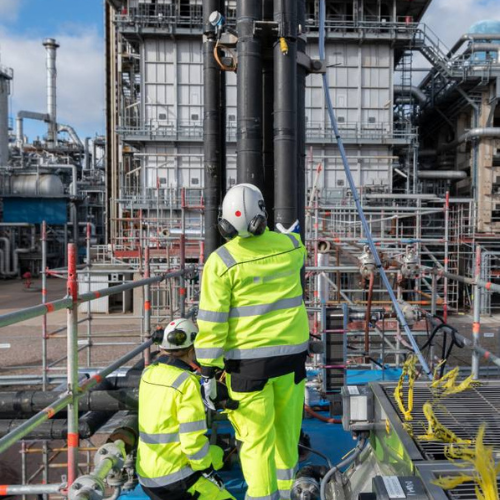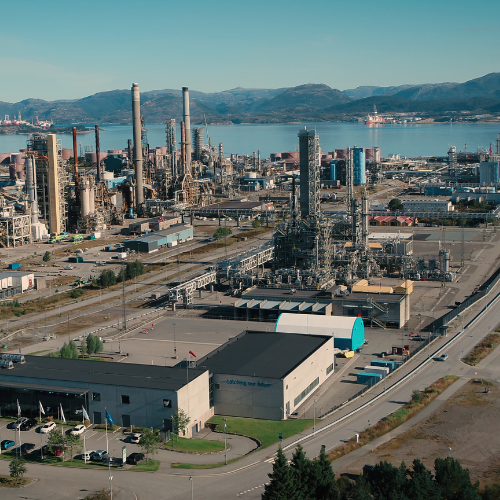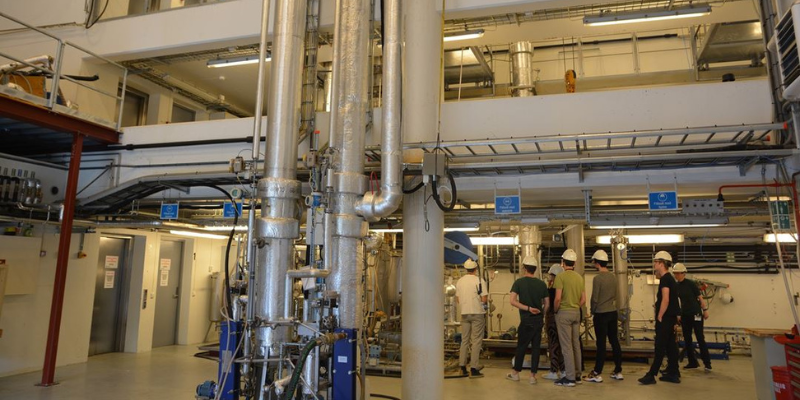Επιτάχυνση των λύσεων δέσμευσης άνθρακα
Πιλοτικές εγκαταστάσεις AURORA που δοκιμάζουν τον διαλύτη CESAR1
Σημαντικό μέρος του έργου AURORA είναι η δοκιμή του διαλύτη CESAR1 σε τρεις διαφορετικές υφιστάμενες πιλοτικές εγκαταστάσεις, οι οποίες διαφέρουν ως προς τη δυναμικότητά τους, προκειμένου να επαληθευτούν τα αποτελέσματα της κλίμακας, καθώς και ως προς τα χαρακτηριστικά των δοκιμών τους.
CO2 laboratory, Tiller –
SINTEF
Επίσκεψη στο εργαστήριο ↓
SINTEF - Tiller laboratori
Το CO2 Το εργαστήριο Tiller στο Trondheim της Νορβηγίας είναι μια άρτια εξοπλισμένη εγκατάσταση δοκιμών για την ανάπτυξη συστημάτων μετακαύσης CO2 τεχνολογίες δέσμευσης, καθώς και ένα ερευνητικό εργαστήριο για την ανάλυση της προεπεξεργασίας των καυσαερίων και την έρευνα για τις εκπομπές. Είναι ιδιαίτερα ευέλικτο και σχεδιασμένο για τη δοκιμή διαφορετικών διαλυτών σε διάφορες συνθήκες καυσαερίων.
Κινητή μονάδα δοκιμής
– slb Capturi
Επίσκεψη στο εργαστήριο ↓
slb Capturi - MTU
Η Κινητή Μονάδα Δοκιμών (MTU) που ανήκει στην slb Capturi είναι μια αρθρωτή μονάδα CO2 εγκατάσταση δοκιμών σύλληψης. Είναι εύκολο να μεταφερθεί και να ενσωματωθεί στις υπάρχουσες εγκαταστάσεις των μονάδων επεξεργασίας και παράγει αντιπροσωπευτικά δεδομένα για τις βιομηχανικές εγκαταστάσεις CO2 εφαρμογές σύλληψης.
Τεχνολογικό Κέντρο Mongstad - TCM
Επίσκεψη στο εργαστήριο ↓
TCM - βιομηχανικό πάρκο
Το Τεχνολογικό Κέντρο Mongstad (TCM) είναι το μεγαλύτερο κέντρο δοκιμών στον κόσμο για την ανάπτυξη συστημάτων CO2 τεχνολογίες δέσμευσης και ένα από τα κορυφαία κέντρα ικανοτήτων για τη δέσμευση άνθρακα. Το TCM βρίσκεται σε μια σύνθετη βιομηχανική εγκατάσταση στη δυτική ακτή της Νορβηγίας.
Πείραμα AURORA
Μια συλλογική προσπάθεια για ένα βιώσιμο μέλλον
Σήμερα υπάρχουν διάφορες οδοί δέσμευσης άνθρακα, οι οποίες διακρίνονται σε τρεις κατηγορίες: διεργασίες πριν από την καύση, διεργασίες μετά την καύση και διεργασίες οξυγονοκαύσης.
Καθώς η μετακαύση είναι ο ευκολότερος τρόπος ενσωμάτωσης της δέσμευσης του άνθρακα σε υφιστάμενες μονάδες, έχει αναπτυχθεί ευρέως τα τελευταία χρόνια και είναι κατάλληλη για ανάπτυξη σε μεγάλη κλίμακα.
Ενώ οι στερεοί προσροφητές και τα συστήματα μεμβρανών αγωνίζονται να επιτύχουν το συνδυασμένο στόχο του ποσοστού δέσμευσης 90% και της καθαρότητας 95%, οι διεργασίες χημικής απορρόφησης μπορούν να επιτύχουν ακόμη υψηλότερες τιμές CO2 ποσοστά δέσμευσης από το 90% που χρησιμοποιείται σήμερα, και ακόμη και κοντά στο 100% χωρίς σημαντική αύξηση της σχετικής εισροής θερμότητας.
Επιπλέον, η καθαρότητα του CO2 που παράγεται σε αυτά τα συστήματα είναι εγγενώς υψηλή (πάνω από 99%).
Οι προκλήσεις της δέσμευσης άνθρακα
Optimising and Qualifying CESAR1 solvent
Η τεχνολογία που βασίζεται στην απορρόφηση χρειάζεται μείωση του κόστους και ελαχιστοποίηση των περιβαλλοντικών επιπτώσεων. Προκειμένου να μετατραπεί γρήγορα η έρευνα σε πρακτικές εφαρμογές και να καταστεί δυνατή η υιοθέτηση της CCUS σε CO2-εντατικών βιομηχανιών, οι εταίροι της AURORA θα βελτιστοποιήσουν και θα αξιολογήσουν τον μη ιδιόκτητο διαλύτη CESAR1 και τη σχετική διαδικασία. Αυτό θα τους προετοιμάσει για την ανάπτυξη των πρώτων στο είδος τους εγκαταστάσεων ως επόμενο βήμα.

Πλήρης αξιολόγηση της αλυσίδας CCUS
Οι στόχοι της επίδειξής μας
Το έργο θα ενσωματώσει νέες καινοτομίες σε τέσσερα βελτιστοποιημένα συστήματα CO2 διαδικασίες καταγραφής και να τις επιδείξουν σε πιλοτικά έργα διαφόρων μεγεθών και πολυπλοκότητας. Οι εταίροι θα διασφαλίσουν ότι τα αποτελέσματα μπορούν να εφαρμοστούν και σε άλλες μονάδες παραγωγής CO2-εντατικών βιομηχανιών με την αντιμετώπιση διαφόρων εκπομπών CO2 πηγές και με τη συμμετοχή πολυάριθμων ενδιαφερομένων. Επιπλέον, θα διεξαχθούν ολοκληρωμένες αξιολογήσεις της αλυσίδας CCUS (δέσμευση, χρήση και αποθήκευση άνθρακα) για τελικούς χρήστες που βρίσκονται σε δύο διαφορετικές ευρωπαϊκές περιοχές, καθεμία από τις οποίες παρουσιάζει μοναδικές συνθήκες για την εφαρμογή αλυσίδων αξίας CCUS.
Ολιστική βελτιστοποίηση της σύνθεσης του διαλύτη, του σχεδιασμού της διεργασίας, της παρακολούθησης και του ελέγχου των εκπομπών και της διαχείρισης του διαλύτη.
Επικυρωμένα μοντέλα για χρήση σε εμπορικούς προσομοιωτές διεργασιών.
Ενισχυμένη ενσωμάτωση θερμότητας αποβλήτων με δέσμευση άνθρακα για μειωμένη εξωτερική ζήτηση θερμότητας και λειτουργικό κόστος.
Βελτιωμένο και ολοκληρωμένο προηγμένο σύστημα ελέγχου για μειωμένο OPEX και βελτιστοποιημένες επιδόσεις.
Καινοτόμος τεχνολογία διαλυτών
Ρίξτε μια πιο προσεκτική ματιά στην πρόοδο του πειράματος AURORA στους ιστότοπους των τελικών χρηστών...
SINTEF Launches 6-Month CESAR1 Pilot Campaign at Tiller CO2LAB
We are excited to announce that the six-month CESAR1 pilot campaign has officially begun at SINTEF’s Tiller CO2LAB. Starting in the last week of August, this comprehensive campaign will play a crucial role in advancing carbon capture technology. The goal is to conduct 115 tests on the CESAR1 solvent and…
On-site flue gas characterization carried out by SINTEF at Motor Oil Refinery in Agioi Theodoroi, Corinthos, Greece
Motor Oil had the pleasure of welcoming its AURORA partners at the Refinery in Agioi Theodoroi, Corinthos, Greece, last week, 11th to 15th March 2024. The whole week was devoted to on-site measurements carried out by SINTEF experts, using specialised instruments for gas and particle analysis on the hydrogen production…
The methodology for full chain CCUS assessment and cluster development is established
The first deliverable of Work Package 5 on the Full chain CCUS assessment has been issued. This report results from continuous discussions and workshop between all partners during the first year. It is co-authored by TotalEnergies, SINTEF, UNIROMA1 and Cambridge University.Links between the different blocks of a full CCUS chainThis…
The methodology for assessment of the AURORA technology and qualification of the CESAR1 solvent is established
The final aim of the AURORA project is to qualify the CESAR1 solvent for commercial deployment and to establish this solvent and its associated absorption process as the new benchmark for CO2 capture. This requires that the performance of the solvent is known and that any risks in the deployment of…
Getting ready: Motor Oil and HERACLES set date for onsite flue gas characterization with SINTEF experts!
The Motor Oil refinery and the HERACLES cement plant in Greece are both preparing on site and have set dates in March 2024 for flue gas characterization with SINTEF experts. An in-depth analysis will be carried out respectively on the hydrogen production unit and the kiln stack.HERACLES cement plant, GreeceMotorOil…
Installation and operation of the MTU (Mobile test Unit) pilot unit at the Volos plant
During the period January-September 2023, the HERACLES team carried out the authorisation procedures for the installation and operation of the MTU pilot unit at the Volos plant. The HERACLES team worked with its partners on on-site flue gas characterisation and on the methodology for evaluating and technologically qualifying large-scale capture…









